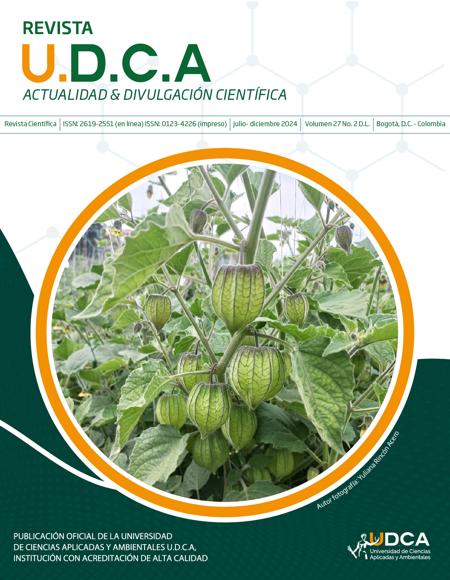Identificación inmunohistoquímica de las citoqueratinas 14 y 19 durante el desarrollo dental
Immunohistochemical identification of cytokeratin 14 and 19 during dental development
Contenido principal del artículo
Resumen
La formación de los dientes tiene gran importancia en la vida animal gracias a funciones, como la alimentación, la fonética o el ataque-defensa. La biomineralización fisiológica del desarrollo del órgano dental correspondiente al incisivo, diente de crecimiento continuo en ratones, constituye un modelo de investigación, que permite comprender los procesos involucrados en la formación de los tejidos mineralizados dentarios (esmalte y dentina) y periodontales (cemento y hueso alveolar). En estos procesos, pocos comprendidos fisiológicamente, participan epiteliocitos y filamentos intermedios de citoqueratinas (CK). Actualmente, el conocimiento sobre la identificación, la distribución y la participación de las CK durante la odontogénesis, particularmente, las CK19 y CK14, es escaso. Por ello, el objetivo del presente trabajo fue identificar y describir la expresión inmunohistoquímica de CK 19 y 14 durante el desarrollo dental. Para ello, se analizaron 12 incisivos de crecimiento continuo de ratones macho Swiss WT (Janvier, St Berthevin), de 7 días de nacidos. El estudio comprendió un análisis inmunohistoquímico con anticuerpos primarios monoclonales de conejo anti-CK 14 y anti-CK 19. Las observaciones se realizaron en un microscopio Leica DM6. Los resultados muestras que la CK19 se localiza en la lámina dental, las células del asa cervical y de la pulpa dental, mientras que la CK14, se localiza, esencialmente, en la lámina dental, ameloblastos y dentinoblastos. Se recomiendan futuros análisis inmunohistoquímicos (CK19/CK14) en ratones transgénicos, con el propósito de lograr una mayor comprensión de la función de estas CK, durante la formación dental.
Palabras clave:
Descargas
Datos de publicación
Perfil evaluadores/as N/D
Declaraciones de autoría
- Sociedad académica
- Universidad de Ciencias Aplicadas UDCA
- Editorial
- Universidad de Ciencias Aplicadas y Ambientales U.D.C.A
Detalles del artículo
Referencias (VER)
AKHILA, C.N.V.; SREENATH, G.; PRAKASH, A.R.; KANTH, M.; REDDY, A.V.S.; KUMAR, S.N. 2021. Expression of stem cell marker cytokeratin 19 in reduced enamel epithelium, dentigerous cyst and unicystic ameloblastoma - A comparative analysis. Journal of Oral and Maxillofacial Pathology. 25(1):136-140. https://doi.org/10.4103/jomfp.JOMFP_316_19 DOI: https://doi.org/10.4103/jomfp.JOMFP_316_19
BALZANO, R.; STELLINI, E.; MUCIGNAT-CARETTA, C. 2021. Cell differentiation and replication during postnatal development of the murine first molar. Biology. 10(8):776. https://doi.org/10.3390/biology10080776 DOI: https://doi.org/10.3390/biology10080776
CHENG, Y.; QIN, K.; HUANG, N.; ZHOU, Z.; XIONG, H.; ZHAO, J.; ZHANG, Y.; YU, S. 2019. Cytokeratin 18 regulates the transcription and alternative splicing of apoptotic related genes and pathways in HeLa cells. Oncology Reports. 42(1):301-312. https://doi.org/10.3892/or.2019.7166 DOI: https://doi.org/10.3892/or.2019.7166
DEGRAZIA, D.; BEAUCHAMP, T.L. 2019. Beyond the 3 Rs to a more comprehensive framework of principles for animal research ethics. ILAR journal. 60(3):308-317. https://doi.org/10.1093/ilar/ilz011 DOI: https://doi.org/10.1093/ilar/ilz011
DENG, S.; LEONG, H.C.; DATTA, A.; GOPAL, V.; KUMAR, A.P.; YAP, C.T. 2022. PI3K/AKT Signaling Tips the balance of cytoskeletal forces for cancer progression. Cancers. 14(7):1652. https://doi.org/10.3390/cancers14071652 DOI: https://doi.org/10.3390/cancers14071652
HOSOYA, A.; SHALEHIN, N.; TAKEBE, H.; SHIMO, T.; IRIE, K. 2020. Sonic Hedgehog signaling and tooth development. International Journal of Molecular Sciences. 21(5):1587. https://doi.org/10.3390/ijms21051587 DOI: https://doi.org/10.3390/ijms21051587
INFANTE, E.; ETIENNE-MANNEVILLE S. 2022. Intermediate filaments: Integration of cell mechanical properties during migration. Frontiers in Cell and Developmental Biology. 10:951816. https://doi.org/10.3389/fcell.2022.951816 DOI: https://doi.org/10.3389/fcell.2022.951816
JACOB, J.T.; COULOMBE, P.A.; KWAN, R.; OMARY, M.B. 2018. Types I and II keratin intermediate filaments. Cold Spring Harbor Perspectives in Biology. 10(4):a018275. https://doi.org/10.1101/cshperspect.a018275 DOI: https://doi.org/10.1101/cshperspect.a018275
JHEON, A.H.; SEIDEL, K.; BIEHS, B.; KLEIN, O.D. 2013. From molecules to mastication: the development and evolution of teeth. Wires Mechanism of Disease. 2(2):165-182. https://doi.org/10.1002/wdev.63 DOI: https://doi.org/10.1002/wdev.63
KOIKE, N.; TADOKORO, T.; UENO, Y.; OKAMOTO, S.; KOBAYASHI, T.; MURATA, S.; TANIGUCHI, H. 2022. Development of the nervous system in mouse liver. World Journal of Hepatology. 14(2):386-399. https://doi.org/10.4254/wjh.v14.i2.386 DOI: https://doi.org/10.4254/wjh.v14.i2.386
LEE, S.M.L.; BERTINETTI-LAPATKI, C.; SCHIERGENS, T.S.; JAUCH, K.W.; ROTH, A.B.; THASLER, W.E. 2020. Concurrent isolation of hepatic stem cells and hepatocytes from the human liver. In Vitro Cellular & Developmental Biology - Animal. 56(3):253-260. https://doi.org/10.1007/s11626-020-00433-w DOI: https://doi.org/10.1007/s11626-020-00433-w
LI, B.; TANG, H.; BIAN, X.; MA, K.; CHANG, J.; FU, X.; ZHANG, C. 2021. Calcium silicate accelerates cutaneous wound healing with enhanced re-epithelialization through EGF/EGFR/ERK-mediated promotion of epidermal stem cell functions. Burns & Trauma. 9:tkab029. https://doi.org/10.1093/burnst/tkab029 DOI: https://doi.org/10.1093/burnst/tkab029
LI, S.; GE, S.; YANG, P. 2015. Expression of cytokeratins in enamel organ, junctional epithelium and epithelial cell rests of Malassez. Journal of Periodontal Research. 50(6):846-854. https://doi.org/10.1111/jre.12272 DOI: https://doi.org/10.1111/jre.12272
MINISTERIO DE SALUD, COLOMBIA. 1993. Resolución número 8430 de 1993, por la cual se establecen las normas científicas, técnicas y administrativas para la investigación en salud. Disponible desde Internet en: https://www.minsalud.gov.co/sites/rid/Lists/BibliotecaDigital/RIDE/DE/DIJ/RESOLUCION-8430-DE-1993.PDF
OBARA, N.; SUZUKI, Y.; IRIE, K.; SHIBATA, S. 2017. Expression of planar cell polarity genes during mouse tooth development. Archives of Oral Biology. 83:85-91. https://doi.org/10.1016/j.archoralbio.2017.07.008 DOI: https://doi.org/10.1016/j.archoralbio.2017.07.008
PETERKOVA, R.; HOVORAKOVA, M.; PETERKA, M.; LESOT, H. 2014. Three-dimensional analysis of the early development of the dentition. Australian Dental Journal. 59(1):55-80. https://doi.org/10.1111/adj.12130 DOI: https://doi.org/10.1111/adj.12130
RADLANSKI, R.J.; RENZ, H.; ZIMMERMANN, C.A.; MEY, R.; MATALOVA, E. 2015. Morphogenesis of the compartmentalizing bone around the molar primordia in the mouse mandible during dental developmental stages between lamina, bell-stage, and root formation (E13-P20). Annals of Anatomy. 200:1-14. https://doi.org/10.1016/j.aanat.2015.01.003 DOI: https://doi.org/10.1016/j.aanat.2015.01.003
SAFADI, R.A.; ALROMAIZAN, A.; ALSHAGROUD, R.S.; DIVAKAR, D.D.; ALSHIEBAN, S. 2020. Cytokeratin 19 immunostain reduces variability in grading epithelial dysplasia of the non-keratinized upper aerodigestive tract mucosa. Head and Neck Pathology. 14(1):183-191. https://doi.org/10.1007/s12105-019-01038-w DOI: https://doi.org/10.1007/s12105-019-01038-w
SUKMAWATI, D.; ERYANI, A.; DAMAYANTI, L. 2020. Silver sulfadiazine's effect on keratin-19 expression as stem cell marker in burn wound healing. Biomedicine. 10(2):5-11. https://doi.org/10.37796/2211-8039.1014 DOI: https://doi.org/10.37796/2211-8039.1014
TAKARA, K.; MARUO, N.; OKA, K.; KAJI, C.; HATAKEYAMA, Y.; SAWA, N.; KATO, Y.; YAMASHITA, J.; KOJIMA, H.; SAWA, Y. 2017. Morphological study of tooth development in podoplanin-deficient mice. PLoS One. 12(2):e0171912. https://doi.org/10.1371/journal.pone.0171912 DOI: https://doi.org/10.1371/journal.pone.0171912
YANG, X.; YAMAZAKI, H.; YAMAKOSHI, Y.; DUVERGER, O.; MORASSO, MI.; BENIASH E. 2019. Trafficking and secretion of keratin 75 by ameloblasts in vivo. Journal of Biological Chemistry. 294(48):18475-18487. https://doi.org/10.1074/jbc.RA119.010037 DOI: https://doi.org/10.1074/jbc.RA119.010037
ZHANG, W.; YELICK, P.C. 2021. Tooth repair and regeneration: potential of dental stem cells. Trends in Molecular Medicine. 27(5):501-511. https://doi.org/10.1016/j.molmed.2021.02.005 DOI: https://doi.org/10.1016/j.molmed.2021.02.005
ZHU, X.; LI, Y.; DONG, Q.; TIAN, C.; GONG, J.; BAI, X.; RUAN, J.; GAO, J. 2024. Small molecules promote the rapid generation of dental epithelial cells from human-induced pluripotent stem cells. International Journal of Molecular Sciences 25:4138. https://doi.org/10.3390/ijms25084138 DOI: https://doi.org/10.3390/ijms25084138







